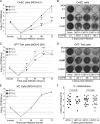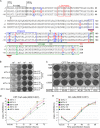Turnover Rate of NS3 Proteins Modulates Bluetongue Virus Replication Kinetics in a Host-Specific Manner
- PMID: 26246581
- PMCID: PMC4580187
- DOI: 10.1128/JVI.01541-15
Turnover Rate of NS3 Proteins Modulates Bluetongue Virus Replication Kinetics in a Host-Specific Manner
Abstract
Bluetongue virus (BTV) is an arbovirus transmitted to livestock by midges of the Culicoides family and is the etiological agent of a hemorrhagic disease in sheep and other ruminants. In mammalian cells, BTV particles are released primarily by virus-induced cell lysis, while in insect cells they bud from the plasma membrane and establish a persistent infection. BTV possesses a ten-segmented double-stranded RNA genome, and NS3 proteins are encoded by segment 10 (Seg-10). The viral nonstructural protein 3 (NS3) plays a key role in mediating BTV egress as well as in impeding the in vitro synthesis of type I interferon in mammalian cells. In this study, we asked whether genetically distant NS3 proteins can alter BTV-host interactions. Using a reverse genetics approach, we showed that, depending on the NS3 considered, BTV replication kinetics varied in mammals but not in insects. In particular, one of the NS3 proteins analyzed harbored a proline at position 24 that leads to its rapid intracellular decay in ovine but not in Culicoides cells and to the attenuation of BTV virulence in a mouse model of disease. Overall, our data reveal that the genetic variability of Seg-10/NS3 differentially modulates BTV replication kinetics in a host-specific manner and highlight the role of the host-specific variation in NS3 protein turnover rate.
Importance: BTV is the causative agent of a severe disease transmitted between ruminants by biting midges of Culicoides species. NS3, encoded by Seg-10 of the BTV genome, fulfills key roles in BTV infection. As Seg-10 sequences from various BTV strains display genetic variability, we assessed the impact of different Seg-10 and NS3 proteins on BTV infection and host interactions. In this study, we revealed that various Seg-10/NS3 proteins alter BTV replication kinetics in mammals but not in insects. Notably, we found that NS3 protein turnover may vary in ovine but not in Culicoides cells due to a single amino acid residue that, most likely, leads to rapid and host-dependent protein degradation. Overall, this study highlights that genetically distant BTV Seg-10/NS3 influence BTV biological properties in a host-specific manner and increases our understanding of how NS3 proteins contribute to the outcome of BTV infection.
Copyright © 2015, American Society for Microbiology. All Rights Reserved.
Figures








Similar articles
-
Bluetongue virus nonstructural protein NS3/NS3a is not essential for virus replication.PLoS One. 2014 Jan 20;9(1):e85788. doi: 10.1371/journal.pone.0085788. eCollection 2014. PLoS One. 2014. PMID: 24465709 Free PMC article.
-
Bluetongue Virus NS4 Protein Is an Interferon Antagonist and a Determinant of Virus Virulence.J Virol. 2016 May 12;90(11):5427-39. doi: 10.1128/JVI.00422-16. Print 2016 Jun 1. J Virol. 2016. PMID: 27009961 Free PMC article.
-
Non-structural protein NS3/NS3a is required for propagation of bluetongue virus in Culicoides sonorensis.Parasit Vectors. 2015 Sep 17;8:476. doi: 10.1186/s13071-015-1063-3. Parasit Vectors. 2015. PMID: 26383094 Free PMC article.
-
[Advances in the release mechanisms of bluetongue virus].Sheng Wu Gong Cheng Xue Bao. 2021 Sep 25;37(9):3179-3189. doi: 10.13345/j.cjb.210260. Sheng Wu Gong Cheng Xue Bao. 2021. PMID: 34622626 Review. Chinese.
-
[The significance of the structural characteristics of the agent for the problems of immunization against blue tongue].Tierarztl Prax. 1991 Dec;19(6):591-5. Tierarztl Prax. 1991. PMID: 1665600 Review. German.
Cited by
-
Dissection and integration of the autophagy signaling network initiated by bluetongue virus infection: crucial candidates ERK1/2, Akt and AMPK.Sci Rep. 2016 Mar 15;6:23130. doi: 10.1038/srep23130. Sci Rep. 2016. PMID: 26976147 Free PMC article.
-
Virus-induced autophagic degradation of STAT2 as a mechanism for interferon signaling blockade.EMBO Rep. 2019 Nov 5;20(11):e48766. doi: 10.15252/embr.201948766. Epub 2019 Oct 11. EMBO Rep. 2019. PMID: 31603272 Free PMC article.
-
Bluetongue's New Frontier-Are Dogs at Risk?Vet Sci. 2025 May 20;12(5):505. doi: 10.3390/vetsci12050505. Vet Sci. 2025. PMID: 40431598 Free PMC article. Review.
-
Inhibition of the IFN Response by Bluetongue Virus: The Story So Far.Front Microbiol. 2021 Jun 8;12:692069. doi: 10.3389/fmicb.2021.692069. eCollection 2021. Front Microbiol. 2021. PMID: 34168637 Free PMC article. Review.
-
Intranasal Exposure to Rift Valley Fever Virus Live-Attenuated Strains Leads to High Mortality Rate in Immunocompetent Mice.Viruses. 2022 Nov 8;14(11):2470. doi: 10.3390/v14112470. Viruses. 2022. PMID: 36366567 Free PMC article.
References
-
- DuToit RM. 1944. The transmission of blue-tongue and horse sickness by Culicoides. Onderstepoort J Vet Sci Anim Ind 19:7–16.
-
- Price DA, Hardy WT. 1954. Isolation of the bluetongue virus from Texas sheep-Culicoides shown to be a vector. J Am Vet Med Assoc 124:255–258. - PubMed
Publication types
MeSH terms
Substances
Grants and funding
LinkOut - more resources
Full Text Sources
Research Materials

